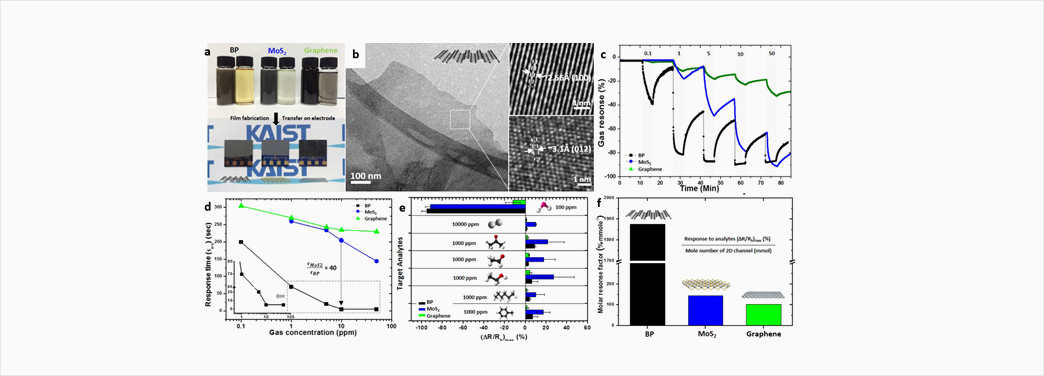Sensing Performance
Soo-Yeon Cho (chosooyeon@kaist.ac.kr)
Advisor: Hee-Tae Jung (heetae@kaist.ac.kr)

Two-dimensional (2D) materials have sparked the interest of scientists due to their exciting prospects for chemical sensing devices: exceptional electrical, mechanical, and surface properties. Large surface-to-volume ratio of the 2D materials leads to dense number of adsorption sites, and the customized sensing channel with appropriate band gap can be easily realized by tuning the number of layers in 2D materials. Also, these materials have various active sites for selective molecular adsorption including vacancy, edge, basal planes, and defects. Furthermore, 2D materials can be operated at room temperature, which is impossible for metal oxide based semiconductors. Thus, 2D materials have been regarded as promising candidates for low-power IoT sensors. However, the currently available 2D materials including graphene, TMDs, and nitride, lack in selectivity, a key performance parameter for sensing materials.
Recently, Prof. Hee-Tae Jung's group reported a new emerging class of 2D materials, black phosphorus (BP), which shows most selective sensing performance among 2D materials. BP is the thermodynamically stable form of phosphorus composed of orthorhombic layered structures. Research teams chemically exfoliated bulk BP crystal into nanosheets, and fabricated chemical sensing devices to understand their sensing abilities. The dynamic sensing results from a number of target gases demonstrate that BP shows ten to twenty times higher molar response factor than that of MoS2 and graphene sensors. Moreover, the response time of BP is about 40 times faster than the other 2D materials, having percent per billion (ppb) level sensing ability of the target analytes, which is one of the most sensitive sensing performance among previously reported 2D materials. In addition, only BP shows highly selective response to NO2 molecules and no response to oxygen functionalized molecules, while MoS2 and graphene have similar response to all the chemical compounds. The superior sensitivity/selectivity of BP is further demonstrated with theoretical DFT simulation by Prof. Jihan Kim's group. The results were highly regarded by the experts in the field and published in Advanced Materials (Adv. Mater. 2016, 28, 7020
-7028).





